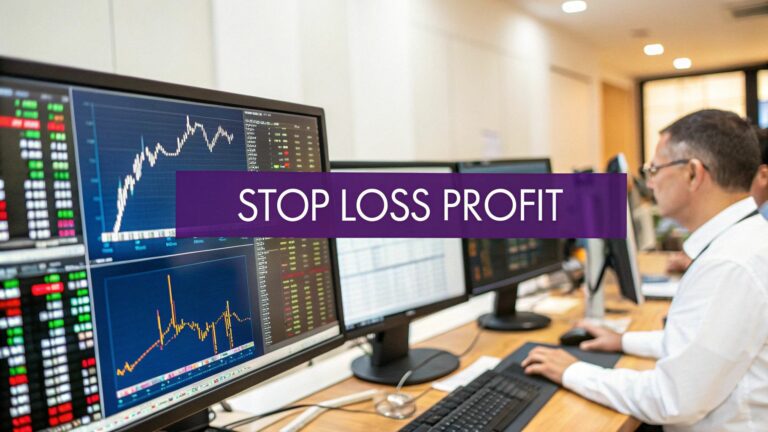When you boil it all down, trading success isn't just about picking winners. It’s about managing your emotions and, just as importantly, managing your risk. Two of the most powerful tools you have for this are the stop loss and the take profit order.
Think of a stop loss as your financial parachute. It's an order you set beforehand that automatically gets you out of a losing trade at a specific price, preventing a small mistake from turning into a devastating loss. On the flip side, a take profit order is your designated finish line, automatically closing a winning trade to lock in those gains before the market has a chance to turn against you.
Your Essential Tools for Disciplined Trading
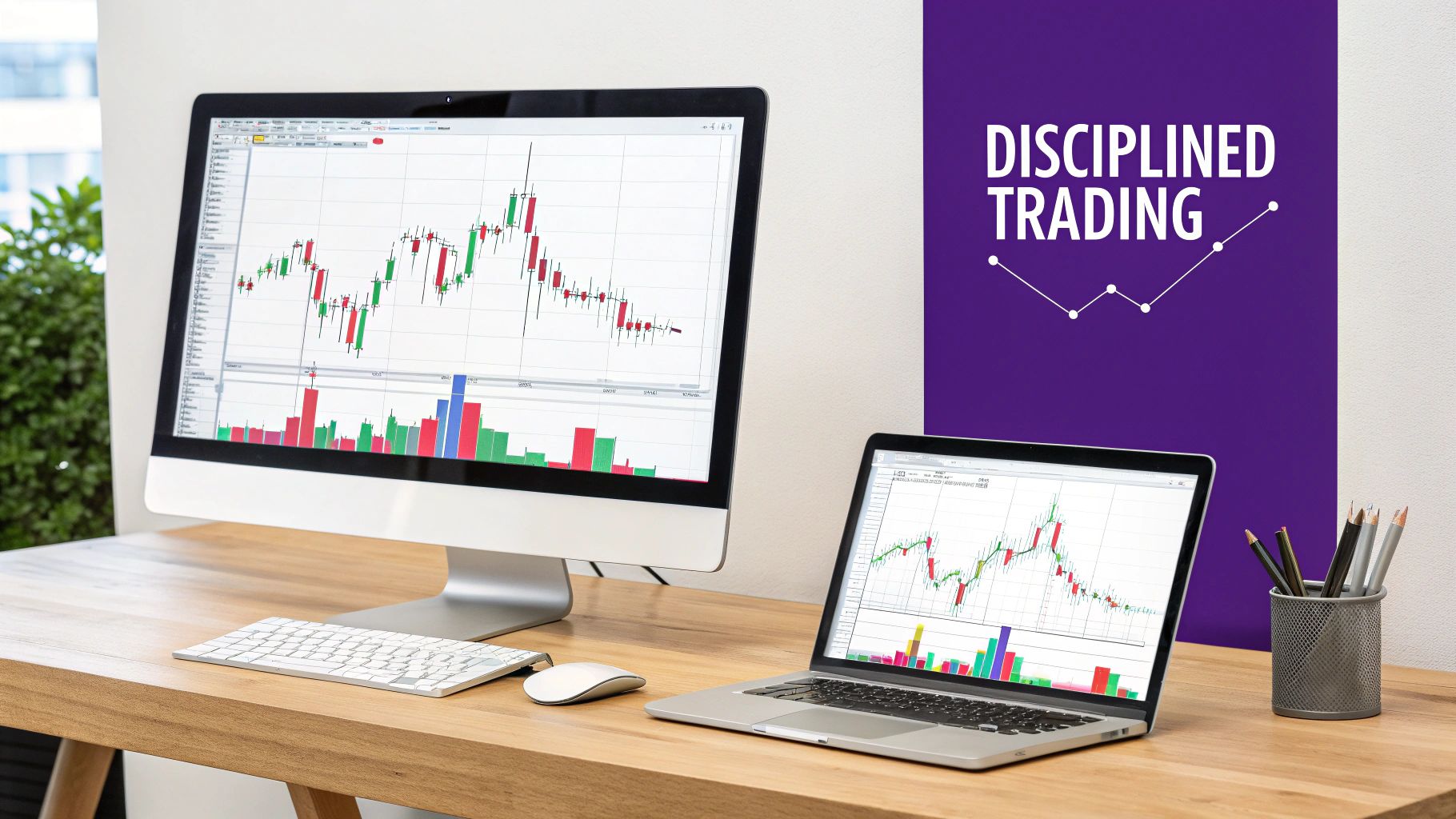
The best traders know that winning isn't about hitting grand slams every time; it's about consistently protecting your capital. That’s precisely why stop loss and take profit orders are so indispensable. They take your trading plan from a vague idea in your head and turn it into a concrete, automated action in the market.
By setting these orders before you even enter a trade, you make your most critical exit decisions with a clear head, free from the heat-of-the-moment emotions that wreck so many accounts. This guide will go beyond the dictionary definitions to show you how the pros use these orders to stay disciplined, protect their accounts, and trade with genuine confidence.
The Foundation of Emotional Control
Let's be honest: the two biggest enemies of any trader are fear and greed. Fear makes you bail on a good trade too early or cling to a losing one, praying for a comeback. Greed whispers in your ear to let a winner run just a little bit further, only to watch all your hard-earned profits evaporate.
A stop loss is your antidote to fear-based decisions. A take profit is your defense against greed. Using them together is how you build a framework for trading like a machine—cool, calm, and systematic.
Key Benefits of Using Exit Orders
Putting a solid stop loss and take profit strategy into practice offers immediate, real-world benefits that can completely change your trading game. For anyone serious about making it in the markets long-term, these aren't optional—they're fundamental.
- Capital Preservation: A stop loss is your number one line of defense. It ensures that a couple of bad calls don't wipe out your account.
- Profit Realization: A take profit order is what turns your smart analysis into actual money in your account. It banks the "paper profits" for real.
- Reduced Stress: Automating your exits means you can walk away from the screen. Your plan is locked in, protecting you from both downside risk and the regret of missed opportunities.
- Improved Discipline: These orders force you to think through your entire trade, from entry to exit, before you risk a single dollar. That's how professional habits are built.
This level of discipline is especially crucial for anyone involved in short-term strategies. For a deeper dive, check out these effective day trading tips from some trusted voices in the industry. And to keep building that solid foundation of knowledge, the vTrader Academy is packed with resources. You can learn more about essential trading concepts at the vTrader Academy and really start sharpening your edge.
How Do Stop Loss and Take Profit Actually Work?
At its heart, trading is a game of probabilities. Winning isn't about being right every single time—it's about managing the outcomes when you're wrong and capitalizing when you're right. To do that, you need tools that execute your plan perfectly, without emotion getting in the way.
That’s exactly where stop loss and take profit orders come in. Think of them as your non-negotiable, pre-programmed rules of engagement for every trade.
Let's use an analogy. Imagine you're a fighter pilot navigating volatile skies. A stop loss order is your eject button. Before you even leave the tarmac, you decide the exact point where the mission becomes too dangerous. If things go south and you hit that critical altitude—or in trading, a specific price—the system automatically ejects you, saving you from a catastrophic crash. It's your escape plan, set in stone.
On the other hand, a take profit order is your mission objective. It's the pre-planned target you're aiming for. Once you hit it, your mission is a success, and you automatically head back to base with your victory locked in. This keeps you from getting greedy and pushing your luck, a classic mistake that can quickly turn a winning trade into a losing one.
The Mechanics Behind an Automated Exit
When you open a trade, you can attach these two conditional orders to it. They just sit there, dormant, waiting for the market to hit one of your price triggers. The market doesn't care about your hopes or fears, but it follows these price-based instructions with robotic precision.
This simple setup creates a defined risk-to-reward ratio for every single position you take. You establish the maximum you're willing to lose and the profit you're targeting before the pressure is on.
By setting your stop loss and take profit levels in advance, you make your most critical decisions with a clear, rational mind—not one clouded by the fear of loss or the thrill of a winning streak.
Let's walk through how each of these orders plays out in the real world.
A Practical Stop Loss Example
Let’s say you buy Bitcoin at $60,000, convinced the price is heading higher. But you're a disciplined trader, so you need to protect your capital just in case you're wrong. You decide you’re only willing to risk $1,000 on this idea.
- Your Move: You place a stop loss order at $59,000.
- The Result: If Bitcoin’s price unexpectedly drops and hits $59,000, the vTrader platform automatically triggers a sell order, closing you out of the trade.
- The Payoff: Your loss is capped at around $1,000 (plus any minor fees or slippage). You've taken a small, controlled loss instead of watching your account drain away.
This one automated action saves you from the temptation to "just wait and see if it bounces back"—a psychological trap that has wiped out countless traders.
A Practical Take Profit Example
Sticking with the same trade, your analysis tells you that Bitcoin has a good shot at hitting $63,000 before running into resistance. That looks like a solid target to lock in your gains.
- Your Move: You set a take profit order right at $63,000.
- The Result: If the market rallies and the price touches $63,000, the platform instantly sells your position for you.
- The Payoff: You’ve successfully locked in a $3,000 profit. The order executes immediately, so you don't have to worry about the price hitting your target for a split second and then reversing before you can react manually.
Together, these two orders create a complete exit strategy. As soon as one of them is triggered, the other is automatically cancelled. This is often called a "one-cancels-the-other" (OCO) order, a key feature that simplifies how you manage your trades. For more details on the specifics, you can always check out the vTrader terms and conditions.
Using stop loss and take profit orders isn’t just a fancy feature; it’s the bedrock of disciplined and sustainable trading.
Why Every Trader Needs a Risk Management Plan
Jumping into the markets without a solid risk management plan is a bit like setting sail across the ocean with no compass. You might catch a lucky wind for a while, but eventually, you’ll be at the mercy of the currents. Using stop loss and take profit orders is how you build that compass—it turns trading from a gamble into a calculated business.
By deciding your exit points before you even enter a trade, you take the two biggest enemies of a trader out of the equation: fear and greed. These emotions are notorious for making even the best traders abandon a solid strategy at the worst possible moment.
Taming Emotions with a Pre-Set Strategy
We’ve all been there. A trade goes against you, and fear kicks in, tempting you to hold on just a little longer, praying for a turnaround. On the flip side, when a trade is in profit, greed whispers in your ear to let it ride, only for you to watch those gains vanish. A risk management plan is your emotional circuit breaker.
Your stop loss is a logical, pre-planned decision to cap a loss before it gets out of hand. Your take profit is a disciplined, pre-planned decision to lock in your winnings. Together, they execute your plan with cold, hard precision, no matter how you’re feeling.
The Power of a Favorable Risk-Reward Ratio
A cornerstone of any good plan is the risk-reward ratio. It’s a simple but powerful metric that compares how much you’re willing to lose (the distance to your stop loss) against how much you stand to gain (the distance to your take profit). Many experienced traders won’t even consider a trade unless the potential reward is at least twice the risk (a 1:2 ratio).
This simple rule ensures your winners are big enough to more than cover your losers. You don't have to win every time to be profitable; your wins just need to pack a bigger punch than your losses.
Take a look at how this plays out. This chart shows how different risk-reward ratios can dramatically impact your potential returns, even with the same amount of risk on each trade.
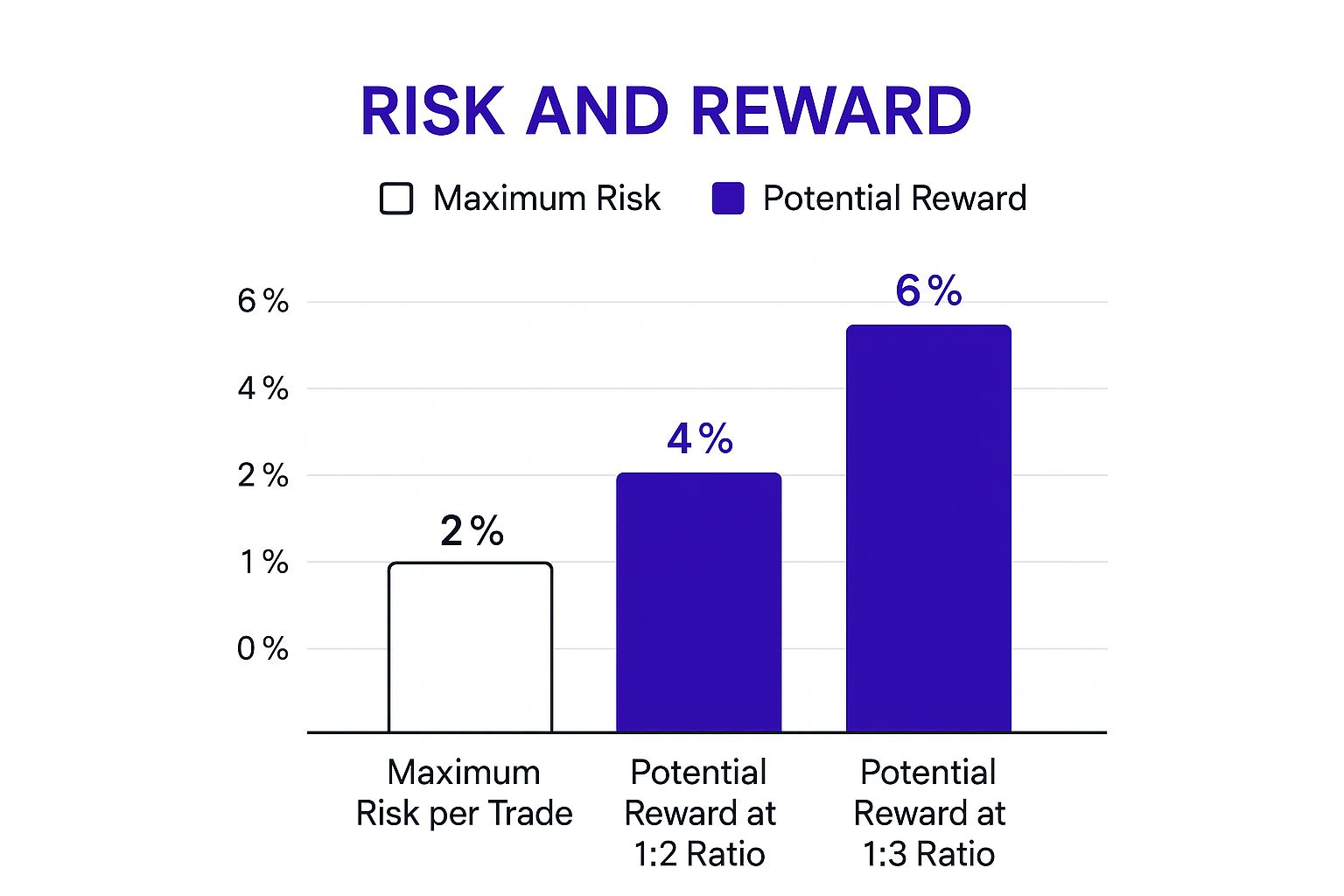
As you can see, simply targeting a 1:3 ratio instead of a 1:2 ratio can supercharge your account's growth over time—all without risking a single penny more on any individual trade.
To see the difference in black and white, here’s a quick comparison of trading with a plan versus flying blind.
Risk Management Strategy Comparison
| Aspect | With Stop Loss & Take Profit | Without Stop Loss & Take Profit |
|---|---|---|
| Emotional State | Calm, disciplined, and strategic. | Anxious, prone to fear and greed. |
| Decision Making | Logical and pre-planned. | Impulsive and reactive. |
| Capital Protection | Losses are capped at a defined level. | A single bad trade can wipe out an account. |
| Profitability | Consistent, based on a positive win/loss ratio. | Inconsistent, often giving back profits. |
| Long-Term Viability | Sustainable and professional approach. | High chance of blowing up the account. |
Having a defined plan transforms trading from a rollercoaster of emotions into a systematic process.
Protecting Your Capital is Your First Priority
At the end of the day, a trader's number one job is to protect their capital. A well-placed stop loss is your shield. It guarantees that one or two bad trades won’t take you out of the game for good. It’s the golden rule in action: live to trade another day.
This isn't just talk. One deep-dive quantitative study found that using a stop-loss strategy consistently beat a simple buy-and-hold approach over an 11-year period. The data showed a 15% stop-loss level delivered the best average quarterly returns, while a 10% stop-loss racked up the highest cumulative return of 57.1%.
"The essence of risk management lies in maximizing the areas where we have some control over the outcome while minimizing the areas where we have absolutely no control." – Peter L. Bernstein
This control is what separates the pros from the amateurs. Of course, while these orders help you manage market risk, every trade has costs. A complete plan also accounts for fees, which is why understanding your platform’s structure is key. You can see how vTrader's zero-fee trading approach fits into a risk-first strategy. Making stop-loss and take-profit orders a non-negotiable part of your routine is the most practical step you can take toward becoming a serious trader.
How to Set Effective Stop Loss and Take Profit Levels
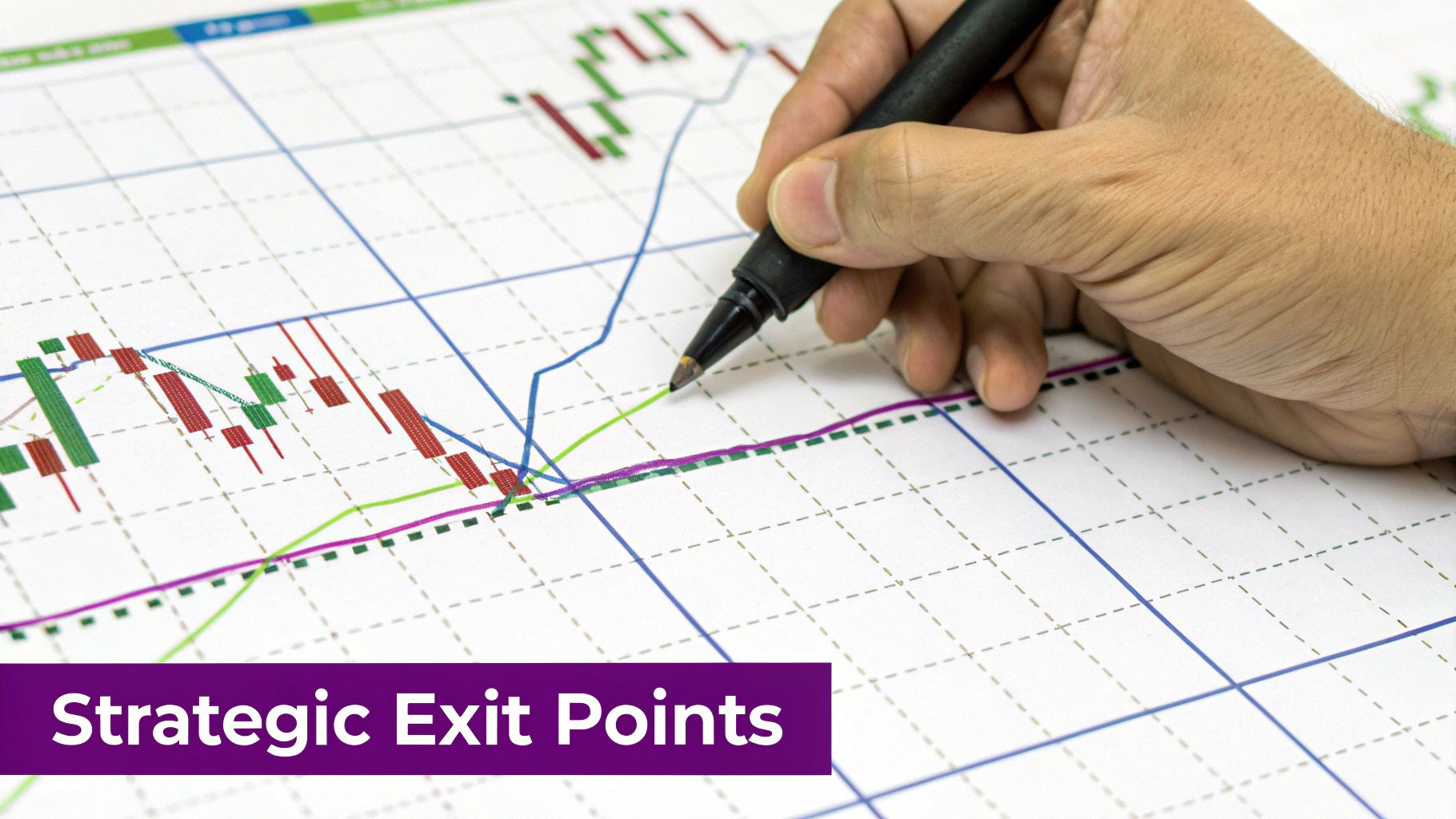
Here's where the rubber meets the road. Moving past arbitrary numbers is the secret to unlocking the true power of your stop loss and take profit orders. Instead of just picking a percentage out of thin air, seasoned traders set their exit points based on what the market is actually telling them. This means diving into technical analysis to find logical, data-driven levels for every single trade.
When you let the market’s structure guide your decisions, you take the guesswork out of the equation. It aligns your strategy with the natural ebb and flow of price action, turning your stop loss from a simple safety net into a smart, strategic tool.
Using Support and Resistance for Placement
One of the most battle-tested methods is using support and resistance levels. Just think of these as price floors and ceilings where the market has historically shown strong buying or selling pressure.
A support level is a price point where an asset has repeatedly stopped falling and bounced back up. Placing your stop loss just below a major support level is a classic, logical move. This gives your trade room to breathe while making sure you get out if sentiment truly turns sour and the price breaks through that floor.
On the flip side, a resistance level is a price ceiling where an asset has struggled to push higher in the past. This makes it the perfect spot to set your take profit order. By placing your target just below a key resistance area, you dramatically increase the odds of your order getting filled before sellers jump in and potentially reverse the price.
Incorporating Volatility with Average True Range
Markets are living, breathing things. Some are calm and predictable, while others are wild roller coasters. A one-size-fits-all, fixed-percentage stop loss just doesn't work because it ignores this crucial difference. A 5% drop might be just another Tuesday for a volatile altcoin, but for a more stable asset, it could signal a major breakdown.
This is where the Average True Range (ATR) indicator becomes your best friend. ATR measures an asset's average volatility over a specific period, giving you a customized yardstick for that particular market. By weaving it into your stop loss strategy, you create an exit point that truly adapts to the asset's unique personality.
For instance, if Bitcoin's current ATR is $1,500, you might set your stop loss at 1.5 or 2 times that ATR value below your entry price. This volatility-adjusted stop helps you avoid getting knocked out of a good trade by normal price swings—a painfully frustrating experience known as a "whipsaw." To get a better feel for this, you can explore our detailed BTC price prediction guide to see how these factors come into play.
The Power of the Trailing Stop Loss
What if your stop loss could not only protect your downside but also automatically lock in profits as a trade moves in your favor? That’s precisely what a trailing stop loss is designed to do. It’s a dynamic order that follows the price up on a long position (or down on a short one) by a specific distance you set.
A trailing stop is the ultimate tool for letting your winners run while systematically protecting your gains. It combines the capital protection of a traditional stop loss with the profit-securing discipline of a take profit order.
Imagine you buy Ethereum at $3,000 and set a 5% trailing stop. Your initial stop loss is set at $2,850. If the price climbs to $3,200, your trailing stop automatically moves up with it to $3,040, locking in a small but guaranteed profit. If ETH continues its run to $3,500, your stop follows it to $3,325. Should the market suddenly reverse and drop, you're stopped out at $3,325, securing a solid win.
This isn’t just theory; the data backs it up. One study comparing fixed stop losses to trailing stops found that trailing stops significantly boosted returns. The research showed that a trailing stop, especially at the 20% level, outperformed a traditional stop-loss by as much as 27.47% cumulatively over an 11-year period.
This simple but powerful tool helps you capture the lion's share of a major trend without the stress of trying to perfectly time the exit.
Common Mistakes to Avoid When Setting Exit Orders
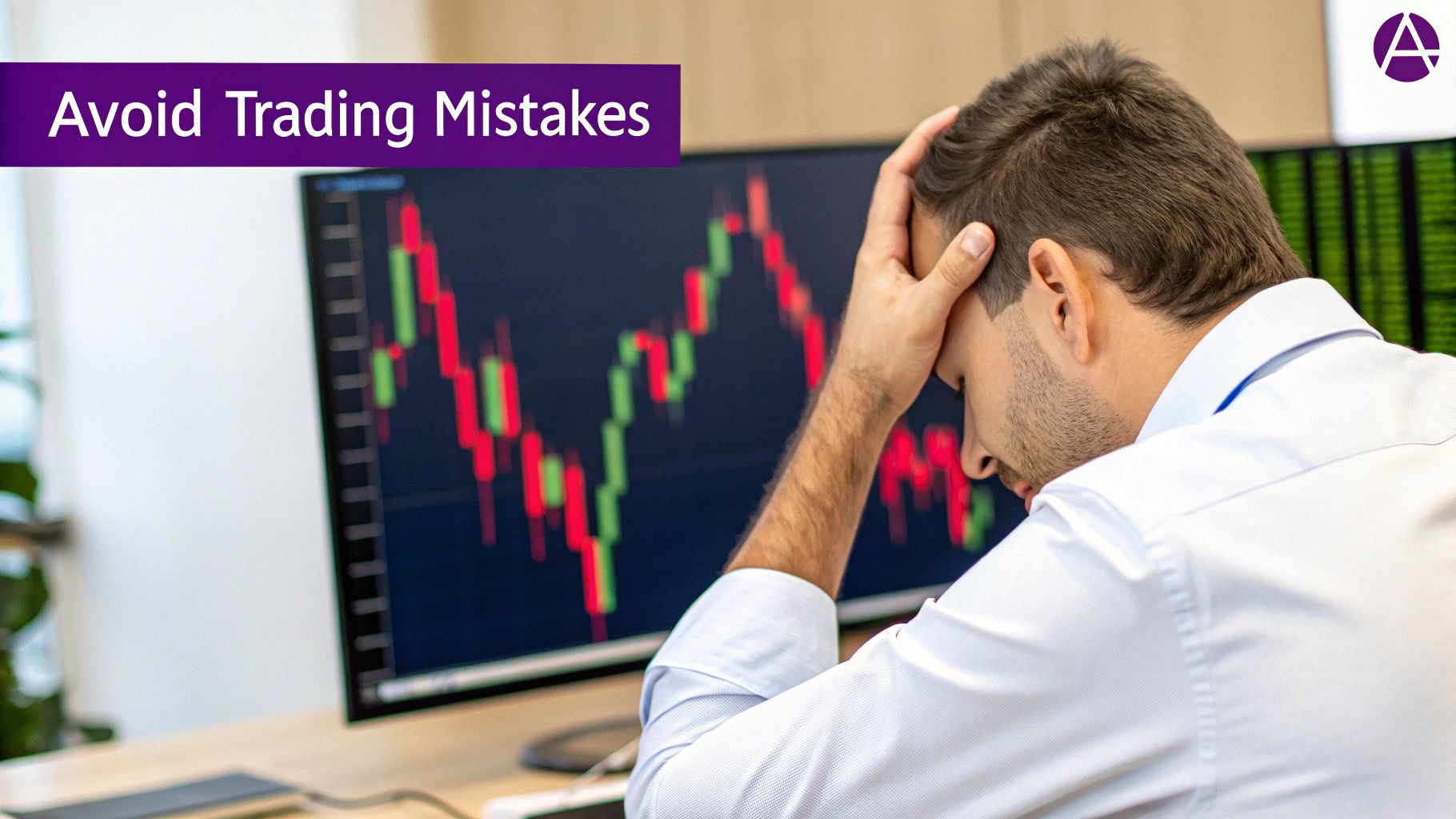
Knowing how to place stop-loss and take-profit orders is one thing. Knowing how to use them without shooting yourself in the foot is another game entirely. Even the best tools are useless if you don't know the classic blunders that can turn a solid strategy into a money-loser.
Getting a handle on these common traps is a massive leap toward building the discipline every successful trader needs.
One of the most common rookie mistakes? Setting your stop-loss way too tight. It feels like you're being super cautious, but more often than not, it completely backfires. Markets are never a straight line up or down; they ebb and flow. This natural "market noise" can easily kick you out of a great trade moments before it takes off in your direction.
It’s an incredibly frustrating experience, and it's why so many traders give up on good strategies. You have to give your trade some breathing room to navigate these minor bumps without hitting the eject button prematurely.
Placing Stops Too Wide or Too Tight
On the flip side, setting a stop-loss that’s too wide is just as bad. Sure, you won't get stopped out by minor blips, but you’ve effectively thrown your risk management plan out the window. A stop-loss that’s 20% below your entry price isn't a safety net; it's an invitation for a catastrophic loss.
The real skill is finding that sweet spot. Your stop needs to be close enough to protect your capital but just far enough away to account for the asset's normal volatility.
- The Tight Stop Trap: You set a stop just a few ticks below your entry on a jumpy stock. The price dips for a second, takes you out, and then skyrockets without you.
- The Wide Stop Trap: You place a stop so far down that when it finally triggers, the loss is big enough to wipe out the profits from your last five winning trades.
Finding that balance is everything for staying in the game long-term.
Letting Emotions Override Logic
This is the big one. The single most destructive habit in trading is moving your stop-loss further down once a trade starts to go against you. It's a move born from pure emotion—hope, fear, and a desperate desire for the market to turn around and prove you were right.
Your initial stop-loss was set with a clear, logical mind. Moving it when you're in a losing position is an emotional reaction that almost always digs a deeper hole. Stick to the plan.
The same logic applies to your take-profit targets. If you're aiming for a 50% gain on a trade that, realistically, only has room to run 5%, you're setting yourself up for failure. Your order will likely never get filled, and you'll watch a profitable position reverse course and turn into a loss—all because greed got in the way of sound analysis.
It's also worth remembering that these orders don't exist in a vacuum. Research from institutions like the Federal Reserve Bank of New York has shown that when too many stop-loss orders pile up around the same price level, they can trigger "price cascades"—a domino effect where one stop sets off a chain reaction of selling.
Frequently Asked Questions About Trading Orders
Even when you’ve got a handle on how stop loss and take profit orders work, things can get tricky in the heat of a live market. Let’s face it, the real world of trading always throws a few curveballs.
Here are some of the most common questions that pop up and the straight-up answers you need.
What Happens if the Market Gaps Past My Stop Loss Price
This is a scenario that keeps a lot of traders up at night, especially when markets get wild. A "gap" is when a price jumps dramatically up or down with zero trading in between—think overnight news or a surprise economic report.
If the market gaps right past your stop loss price, your order will execute at the very next price available. This means you might get out at a worse price than you planned. That gap between your intended exit and the actual one is called slippage. It’s a frustrating but very real part of trading volatile assets, and it’s a powerful reminder that risk management is about controlling what you can, not magically erasing all risk.
Should I Use a Stop Loss for Long-Term Investments
Honestly, it all comes down to your game plan. If you're an active trader, jumping in and out of positions, then a stop loss isn't just an option—it's your lifeline. It's your number one tool for protecting your capital.
But for the long-term, buy-and-hold crowd, the perspective shifts. These investors are often looking years down the road and aren't sweating the small, daily price swings. Instead of a hard stop loss, they're more likely to use triggers like portfolio rebalancing or a major shift in the company's fundamentals to signal it's time to sell.
What Is a Good Risk-Reward Ratio
There's no single "magic" number, but a solid benchmark many traders swear by is a risk-reward ratio of 1:2 or better. In simple terms, for every dollar you're willing to lose, you should be aiming to make at least two dollars in profit.
A strong risk-reward ratio is what gives you a mathematical edge over the long haul. It ensures your wins have enough firepower to more than make up for your losses. With a 1:3 ratio, you only need to be right one out of every four trades just to break even.
Can Brokers See My Stop Loss Orders
Yes, they can. When you place a stop loss or take profit order, it’s visible on the exchange's order book. This has fueled a long-standing, controversial debate about "stop hunting," where some believe big-money players might intentionally push prices to trigger a cascade of stop orders.
Whether it’s a widespread practice or not is up for debate, but it's smart to be aware of the possibility. One pro tip is to avoid setting your stops at obvious, round numbers like $50.00. Instead, use technical analysis to find more strategic levels that are less likely to be targeted.
Have more questions? Dive deeper into our comprehensive vTrader FAQ page for more answers.
Ready to trade with a platform that puts your strategy first? Join vTrader today to experience zero-fee trading, advanced order types, and a suite of tools designed to help you manage risk and secure profits. Start building your portfolio with confidence at https://www.vtrader.io.

Steve Gregory is a lawyer in the United States who specializes in licensing for cryptocurrency companies and products. Steve began his career as an attorney in 2015 but made the switch to working in cryptocurrency full time shortly after joining the original team at Gemini Trust Company, an early cryptocurrency exchange based in New York City. Steve then joined CEX.io and was able to launch their regulated US-based cryptocurrency. Steve then went on to become the CEO at currency.com when he ran for four years and was able to lead currency.com to being fully acquired in 2025.
